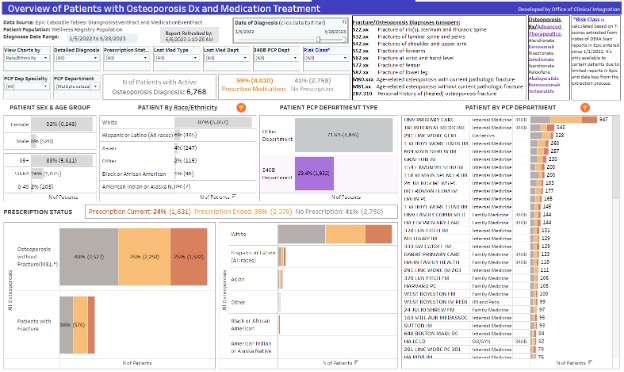Session Information
Date: Tuesday, November 14, 2023
Title: (1996–2018) Osteoporosis & Metabolic Bone Disease – Basic & Clinical Science Poster
Session Type: Poster Session C
Session Time: 9:00AM-11:00AM
Background/Purpose: Osteoporosis and the clinical event of fragility fracture is an ever-increasing public health burden. A significant osteoporosis treatment gap remains, whereby individuals with a fragility fracture are never prescribed therapies for fracture risk reduction. In addition, recent specialty guidelines for the treatment of osteoporosis have started to risk stratify individuals for the purposes of sequential treatment strategies over time. The aim of this work is to utilize multiple sources of data within the electronic medical record (EMR) to identify individuals eligible, but who have not yet received therapies for fracture risk reduction who can then be targeted for intervention.
Methods: Within a single academic health system and focusing on the criteria distinguishing between high- and very high-risk patients as described by specialty guidelines relating to osteoporosis treatment, candidate items were identified to be incorporated into the dashboard. These included 1: demographic data such as race/ethnicity and primary insurance coverage, 2: ICD10 codes on problem lists relating to osteoporosis and fracture, 3: abstraction of T-scores from dual energy x-ray absorptiometry scans, 4: abstraction of vertebral compression fractures from CT and MRI reports and 5: information on prescriptions for FDA-approved medications for fracture risk reduction. The Epic Caboodle database was utilized to obtain most of the data, however, data relating to T-scores and vertebral compression fractures were abstracted separately. Once these individual pieces of data were identified, a treatment dashboard was created to present this data in an actionable format.
Results: An osteoporosis treatment gap dashboard was created (Figure 1) to identify individuals who meet diagnosis for osteoporosis by: ICD 10 code, T-score, vertebral compression fracture noted on CT or MRI reports and to stratify individuals by risk level (presence of fracture, very low t-score), as well as a number of other factors such as age, race/ethnicity, primary care provider and primary insurance coverage. Information on whether an individual has received a therapy for fracture risk reduction is also included. Specific lists of individuals can be generated accordingly, for example by primary care practice, or risk level of future fracture, to allow for locally guided interventions to address the osteoporosis treatment gap.
Conclusion: An osteoporosis treatment gap dashboard has been created which is able to identify and risk stratify individuals who per specialty guidelines would qualify for therapies for fracture risk reduction. Additional work is underway to utilize this dashboard with the aim to reduce the osteoporosis treatment gap.
To cite this abstract in AMA style:
Lyu R, O'Brien P, Wilkie T, Chang Y, Cheah J. Development of an Osteoporosis Treatment Gap Dashboard [abstract]. Arthritis Rheumatol. 2023; 75 (suppl 9). https://acrabstracts.org/abstract/development-of-an-osteoporosis-treatment-gap-dashboard/. Accessed .« Back to ACR Convergence 2023
ACR Meeting Abstracts - https://acrabstracts.org/abstract/development-of-an-osteoporosis-treatment-gap-dashboard/

